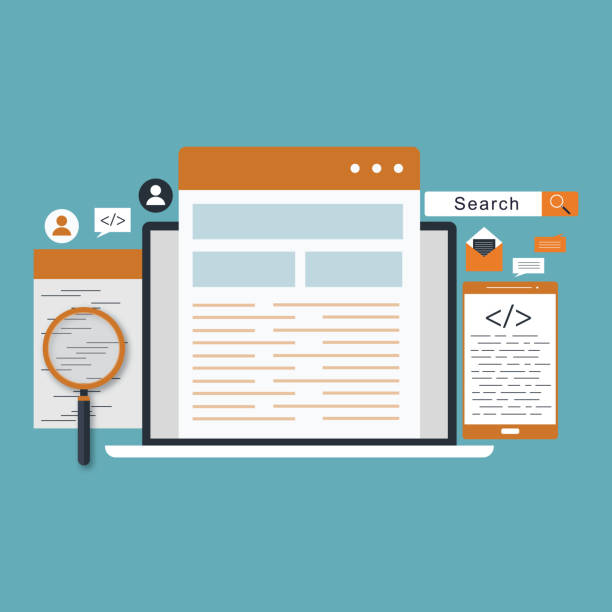Introduction to the Importance of SEO-Optimized Website Design

In today’s digital world, merely having a website is not enough.
Your website must be discoverable to fulfill your business objectives.
This is where the #importance_of_SEO, or search engine optimization, comes into prominence.
Imagine having a beautiful and content-rich website that no one can find.
It’s like having a store in a remote desert.
#Visibility_on_Google and other search engines is crucial for attracting organic traffic, and consequently, #more_visits and #increased_sales.
This is where the concept of SEO-optimized website design gains double importance.
A website designed from the ground up with an SEO approach has a much higher chance of ranking high in search results.
This process includes a set of technical and content-related actions that help search engines better understand your website and present it to relevant audiences.
The main goal of SEO-optimized website design is to provide a strong infrastructure that allows search engines to easily crawl and index your content.
This includes appropriate URL structure, optimized title tags and meta descriptions, high loading speed, and responsiveness across various devices.
These aspects form only a small part of a complete SEO-optimized website design.
In addition to technical aspects, content quality and relevance also play a pivotal role.
A website must be designed to offer a positive user experience, as search engines also pay attention to factors like user dwell time on the site and bounce rate.
In fact, SEO is not just a technique, but a comprehensive approach that should be considered from the very beginning of website design and development to realize its full potential for attracting organic traffic.
This is a long-term investment that yields sustainable results and strengthens your business in the online space.
The educational nature of this approach means a deep understanding of search engine algorithms and how they interact with web content.
This knowledge helps you make more informed decisions about site structure, keyword selection, and content creation.
For example, using a ‘silo’ or ‘tree-like’ site architecture can help search engines better understand your site’s main topics and group related pages together.
Also, adhering to Google Web Vitals standards for evaluating user experience directly impacts your site’s ranking in search results.
For this reason, understanding and implementing these principles in the initial phase of SEO-optimized website design is essential for achieving long-term success.
How much does losing business leads due to an unprofessional website cost you? Solve this problem forever with professional corporate website design by Rasawweb!
✅ Increase credibility and trust of potential customers
✅ Easier attraction of new business leads
⚡ Get a free consultation now!
Key Principles of SEO-Optimized Website Design

For an SEO-optimized website design to be truly successful, a set of technical and structural principles must be observed from the outset.
The first and perhaps most important principle is the hierarchical structure of the website.
A logical and understandable structure makes site navigation easier for both users and search engine bots.
Using a tree-like structure that clearly defines main pages, categories, and subcategories helps search engines understand the thematic relationship between different pages, and this directly impacts page authority and the distribution of SEO power across the site.
The second principle is URL optimization.
URLs should be short, readable, and include the page’s main keyword.
Avoiding unusual characters and using hyphens instead of underscores to separate words are key recommendations.
Also, responsiveness or mobile compatibility is a very critical ranking factor.
Given the significant increase in mobile device usage for searching, your website must provide a flawless user experience on any screen size.
This not only satisfies users but also leads Google’s algorithms to prioritize mobile-friendly websites.
Using Schema Markup is another aspect of SEO-optimized website design that is often overlooked.
Schema is a markup language that helps search engines better understand your website’s content and display more information from it in search results (such as rating stars, product prices, or event information).
This specialized optimization not only helps search engines index your content more accurately but also significantly improves the click-through rate (CTR) by increasing the attractiveness of your site’s display in the SERP (Search Engine Results Pages).
Additionally, optimizing the robots.txt file and XML sitemap are technical necessities.
The robots.txt file tells search engines which parts of your site not to crawl, and the XML sitemap provides them with a list of all indexable pages on your website, which increases the speed of new page indexing and prevents important pages from being missed.
The guidance provided in this section helps you implement the necessary technical infrastructure for an optimized website.
The Role of Content in SEO-Optimized Website Design and Its Production Strategies
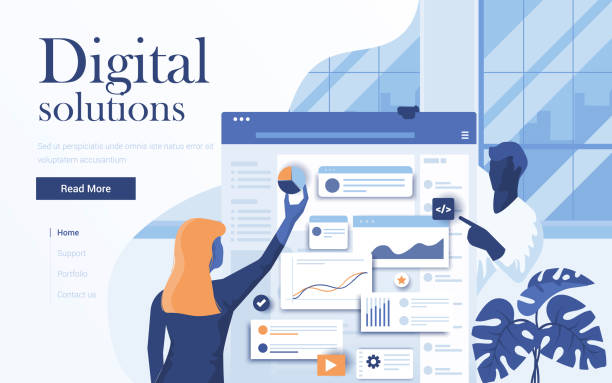
After laying the technical foundation, it’s time for the king of SEO: Content.
An SEO-optimized website design without valuable and relevant content is like a car without fuel.
Content not only attracts users but also shows search engines in what areas your website specializes and for which keywords it should be ranked.
A precise analysis of keywords is the starting point for content creation.
This analysis should include both short and highly competitive keywords (Short-tail keywords) as well as long and specific phrases (Long-tail keywords) that better indicate user intent.
Content quality is more important than anything else.
Your content must be original, informative, comprehensive, and up-to-date.
Copying or producing low-quality content not only doesn’t help with SEO but can also lead to your site being penalized by search engines.
In addition to quality, diversity in content format is also important.
Using blog articles, infographics, videos, podcasts, guides, and FAQs can attract a wider range of audiences and increase their engagement with the site.
Each format has its own advantages and can contribute to SEO-optimized website design in different ways.
For example, videos can increase user dwell time on the page, and podcasts help attract audiences who prefer to receive information audibly.
One of the educational aspects of content creation is understanding what questions users have and how best to answer them.
Creating thought-provoking content that addresses users’ needs and concerns not only keeps them satisfied but also increases your site’s credibility as an authoritative source in the eyes of search engines.
Regularly updating old content and adding new information also sends a positive signal to search engines, indicating that your site is active and dynamic.
Ultimately, it should be remembered that content is written for users, not just for search engines.
By focusing on adding value for the audience, you will naturally achieve your SEO goals as well.
This approach to SEO-optimized website design not only drives more traffic to your site but also brings loyal audiences to you.
Table 1: Types of Content and Their Role in SEO
| Content Type | Role in SEO | Example |
|---|---|---|
| Blog Articles | Attracting organic traffic with targeted keywords, building authority | “Complete Guide to SEO-Optimized Website Design” |
| Infographics | High shareability, backlink generation, attracting attention | “Lifecycle of a Successful SEO Campaign” |
| Videos | Increased user dwell time, improved conversion rate, video SEO | “Step-by-Step Guide to Website Optimization” |
| Frequently Asked Questions (FAQ) | Answering common questions, improving rankings for voice searches | “Common Questions About SEO-Optimized Website Design” |
| Case Studies | Proving expertise and credibility, attracting potential clients | “20% Traffic Increase After SEO Design” |
User Experience (UX) and Its Impact on SEO
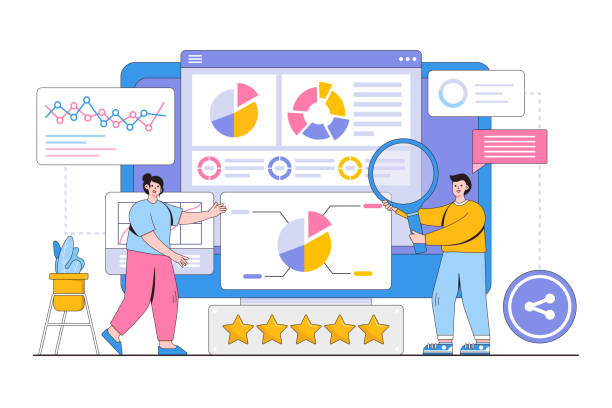
In recent years, the convergence between User Experience (UX) and SEO has become one of the most important topics in the field of SEO-optimized website design.
Google and other search engines are increasingly focusing on factors related to user experience, as their main goal is to provide the best and most relevant results to users.
If a site is technically optimized but has a poor user experience, users will quickly leave it, and this sends a negative signal to search engines.
Factors such as user dwell time on the site (Dwell Time), Bounce Rate, and Pages Per Session are all key UX indicators that indirectly affect SEO ranking.
An SEO-optimized website design that considers UX includes easy and intuitive navigation.
Clear menus, a search bar, and logical internal links help users easily find what they are looking for.
Also, attractive visual design and the use of appropriate fonts and colors improve content readability.
Don’t forget that the main goal of search engines is to provide the best user experience.
The more satisfied users are with your website and the longer they spend on it, the more positive signals are sent to search engines.
This is a comprehensive explanation of the importance of UX.
Other specialized aspects of UX that affect SEO include page loading speed (which directly impacts UX and SEO, and we will discuss it in the next section), accessibility for people with disabilities, and responsive design.
A website that displays correctly and performs well on all devices, from desktop to mobile and tablet, is prioritized by Google.
In short, UX is no longer a luxury option but an essential element for SEO success.
A successful SEO-optimized website design must simultaneously offer excellent design and an outstanding user experience to maintain and enhance its position in intense online competition.
Paying attention to these details not only helps increase your site’s ranking but also leads to user loyalty and improved conversion rates.
Is your online sales not as expected? With Rasawweb, solve the problem of low sales and poor user experience forever!
✅ Increase visitor-to-customer conversion rate
✅ Create an enjoyable user experience and increase customer trust
⚡ Act now to get a free consultation!
The Importance of Loading Speed and Image Optimization in SEO Design

Website loading speed is considered one of the vital and specialized factors in SEO-optimized website design.
Google has explicitly stated that Page Speed is a ranking factor, especially after the introduction of Core Web Vitals metrics.
These metrics include LCP (Largest Contentful Paint), FID (First Input Delay), and CLS (Cumulative Layout Shift), all directly related to user experience and site speed.
A slow website can lead to a high bounce rate and reduced user engagement, even if its content is highly valuable.
Today’s users expect pages to load quickly, otherwise, they simply move on to another site.
To improve speed, there are several key guidelines.
One of the most important is image optimization.
Images often constitute a significant portion of a web page’s size.
Using next-generation image formats like WebP, compressing images without significant quality loss, and specifying correct dimensions for images can dramatically increase loading speed.
Additionally, implementing Lazy Loading for images and videos, meaning content loads only when the user scrolls to that part of the page, greatly impacts reducing the initial page load.
Besides images, optimizing CSS and JavaScript codes, GZIP compression, using a CDN (Content Delivery Network) to deliver content from the closest server to the user, and browser caching are also effective methods for increasing speed.
Caching allows the user’s browser to store static site files so they don’t need to be re-downloaded on subsequent visits.
These specialized measures, though they may seem complex, are vital to ensure your website is fast and efficient.
A truly SEO-optimized website design considers speed in every aspect of itself because it knows that speed equals better user experience and consequently higher search engine rankings.
By observing these points, you will not only keep your visitors satisfied but also please search engines.
Backlinks and Domain Authority in SEO
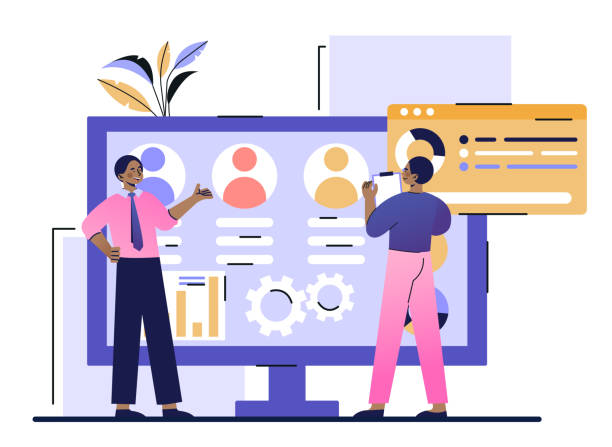
Alongside On-Page SEO, which primarily relates to the structure and content within the website, Off-Page SEO, especially backlinks, plays a pivotal role in determining a website’s credibility and ranking.
A backlink refers to a link from another website pointing to your website.
Search engines consider backlinks as a “vote of confidence” from other websites.
The more numerous and higher quality the backlinks to your website, the more authoritative and trustworthy search engines consider your website to be.
This should be considered a fundamental principle in SEO-optimized website design.
The important point about backlinks is their quality, not merely quantity.
A backlink from a website with high Domain Authority and relevance to your field of activity is far more valuable than dozens of backlinks from spammy or irrelevant sites.
Building natural and high-quality backlinks is a specialized and time-consuming process that requires its own specific strategies.
These strategies can include producing highly valuable content that is naturally linked to, digital public relations, participation in specialized forums, and content dissemination on other platforms.
In addition to backlinks, Domain Authority and Page Authority are also important factors measured by SEO tools like Moz and Ahrefs, indicating the strength of a website or page in the eyes of search engines.
These metrics, although not directly announced by Google, have a strong correlation with rankings and serve as good indicators for evaluating a site’s SEO strength.
A precise analysis of your backlink profile and competitors can reveal the strengths and weaknesses of your off-page SEO strategy and help you move forward on the path of SEO-optimized website design and a successful link-building strategy.
Remember that spam link building or buying low-quality backlinks can lead to severe penalties from Google, so always focus on the quality and naturalness of the link-building process.
Essential Tools for Analyzing and Improving SEO-Optimized Website Design
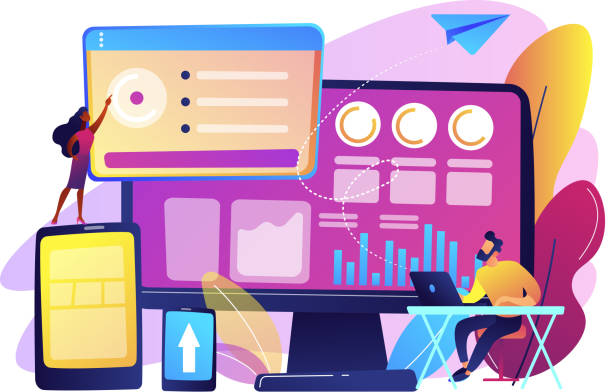
To ensure that your SEO-optimized website design process is on the right track and yields desired results, using appropriate analysis and monitoring tools is essential.
These tools provide you with valuable information about site performance, traffic, keywords, and technical SEO status.
Without these tools, your site’s SEO will be like driving in the dark.
Here, we introduce some of the most important and widely used SEO tools that every SEO specialist and website owner should be familiar with.
Google Search Console is a free and extremely vital tool provided directly by Google.
This tool allows you to monitor your site’s performance in Google search results, identify crawl and indexing issues, and even request re-indexing of pages.
Information related to keywords users used to find your site, internal and external backlinks, and mobile-friendly errors are also viewable in this tool.
Alongside it, Google Analytics gives you deep insight into user behavior on the site, including visitor count, pages viewed, dwell time, and conversion rate.
Together, these two tools provide a comprehensive picture of your site’s SEO and user experience status and are an indispensable part of a comprehensive guide to site optimization.
Specialized paid tools like Ahrefs, Semrush, and Moz are also very useful for deeper SEO analysis.
These tools offer advanced capabilities for keyword research, competitor analysis, backlink monitoring, site auditing, and keyword rank tracking.
Each of these tools has its specific strengths, and choosing the best option depends on your needs and budget.
For example, Ahrefs is very powerful in backlink analysis, while Semrush covers a wide range of features, including paid advertising (PPC) analysis.
Proper use of these tools allows you to support your SEO strategy with accurate data and implement continuous improvements in your SEO-optimized website design.
Table 2: Key SEO Tools and Their Applications
| Tool | Main Use | Advantages |
|---|---|---|
| Google Search Console | Monitoring site performance in Google, detecting crawl and index errors | Free, direct Google data, technical error reports |
| Google Analytics | Analyzing user behavior, traffic sources, conversion rate | Free, in-depth user analysis, customizable reports |
| Ahrefs | Backlink analysis, keyword research, competitor analysis | Massive backlink database, comprehensive keyword research tools |
| Semrush | Keyword research, competitor analysis (organic and paid), site audit | Multifunctional, comprehensive reports, local SEO tools |
| Moz Pro | Domain and page authority, keyword research, rank tracking | DA and PA metrics, active user community, strong educational resources |
Challenges and Misconceptions in SEO-Optimized Website Design

On the path to SEO-optimized website design, there are numerous challenges and misconceptions that can hinder achieving desired results.
One of the most common misconceptions is that SEO is a one-time, magical solution for improving rankings.
Whereas SEO is a continuous and dynamic process that requires ongoing monitoring, analysis, and updating.
Search engine algorithms are constantly changing, and what works today might be ineffective tomorrow.
Therefore, an analytical and adaptable approach is crucial for long-term success.
Another misconception is focusing solely on Keyword Density and stuffing content with them.
This outdated technique, known as “Keyword Stuffing,” not only doesn’t help with SEO but can also lead to your site being penalized by Google.
Today’s search engines have become much smarter and prioritize the quality, relevance, and value of content for the user, not just the number of times a keyword is repeated.
This thought-provoking content helps you gain a deeper understanding of the true nature of SEO.
Another challenge is frustration with quick results.
SEO is a marathon, not a sprint.
Especially for competitive keywords, it can take months to achieve significant results.
Patience and persistence, along with implementing correct strategies, are key to success in this field.
Also, some believe that focusing solely on technical SEO can lead to top rankings, while SEO is a comprehensive approach including content, UX, backlinks, and technical optimizations.
Ignoring any of these aspects can weaken the entire SEO strategy.
Understanding these challenges and avoiding these misconceptions is an important step towards successful SEO-focused website optimization and helps you direct your resources and energy correctly.
Did you know that 94% of the first impression of a company is related to its website design?
Rasawweb helps you create the best first impression by offering professional corporate website design services.
✅ Create a professional and trustworthy image for your brand
✅ Easier attraction of potential customers and improved online standing
⚡ Get a free corporate website design consultation
Future Trends in SEO-Optimized Website Design

The world of SEO is constantly changing and evolving, and what is considered the best practice today may give way to new approaches in the future.
To maintain an edge and ensure the effectiveness of search engine optimized website design, it is essential to be familiar with future trends.
One of the most important and discussed news trends is the increasing role of Artificial Intelligence (AI) in search algorithms.
Algorithms like Google’s BERT and MUM allow search engines to understand user intent with much greater accuracy and provide more relevant results.
This means content must not only include keywords but also answer user questions comprehensively and deeply.
Another trend is the increasing prevalence of Voice Search.
With the expansion of voice assistants like Siri, Google Assistant, and Alexa, people are increasingly using conversational queries for searching.
This means that optimizing for long-tail and question-based keywords, and direct answers, will become more important.
Video SEO has also become a very important area with the popularity of platforms like YouTube and TikTok.
Optimizing video titles, descriptions, tags, and even subtitles to increase their visibility in search results is among the key actions.
E-A-T (Expertise, Authoritativeness, Trustworthiness) will remain a crucial factor for Google, especially in areas that affect users’ health, financial security, or happiness (Your Money Or Your Life – YMYL).
Websites must strive to prove their expertise and be recognized as a trustworthy source.
A deep analysis of user behavior and personalization of search results are also important future trends.
Google increasingly personalizes results based on search history, location, and user preferences.
This means that for a given keyword, results can differ for each user.
Preparing for these changes and adapting your website design strategy with an SEO approach is essential for success in the digital future.
Conclusion and Next Steps for Successful SEO-Optimized Website Design
![]()
As discussed in this comprehensive article, SEO-optimized website design is not merely an option, but a necessity for any business or individual aiming for success in the online space.
This process involves a combination of technical optimizations, valuable content creation, user experience improvement, and link-building strategies, all working towards increasing site visibility in search engines and attracting organic traffic.
A comprehensive and continuous approach is key to achieving and maintaining top Google rankings.
For a successful SEO-optimized website design, your next steps should include:
- Comprehensive SEO Audit: First, evaluate your site’s current SEO status using tools like Google Search Console and Ahrefs to identify strengths and weaknesses.
- Precise Keyword Research: Find keywords relevant to your business and target audience and incorporate them into your content strategy.
- Technical Optimization: Ensure your site is optimized for speed, responsiveness, URL structure, and Schema Markup usage.
- Continuous High-Quality Content Production: Create content that answers user questions, provides valuable information, and is regularly updated.
- Building Quality Backlinks: Focus on acquiring natural backlinks from authoritative sites.
- Continuous Monitoring and Analysis: Use SEO tools to monitor site performance and identify opportunities for improvement.
SEO is a living process and requires continuous attention.
These guidelines will help you take effective steps towards optimizing your website.
By following these principles and the explanation provided throughout this article, you can not only increase your site’s organic traffic but also establish your position as an authoritative and trustworthy source in your field of activity.
Remember that SEO is a long-term investment whose rewards will also be sustainable and significant.
Success in the online world requires commitment to best SEO practices and a willingness to learn and adapt to continuous changes.
Optimizing your site for search engines is a sure way to be seen in today’s highly competitive world.
Frequently Asked Questions
| Question | Answer |
|---|---|
| What is SEO-optimized website design? | Designing a website optimized for both users and search engines to achieve higher rankings. This includes adhering to technical, content, and user experience principles. |
| Why is SEO important in website design? | SEO’s importance in website design stems from its ability to increase site visibility in search results, attract organic traffic, improve user experience, and boost user credibility and trust. |
| What are the most important elements of SEO-friendly website design? | Mobile responsiveness, high loading speed, clear navigation structure, proper use of heading tags (H1-H6), image optimization, and high-quality content. |
| What is the impact of responsiveness (mobile-friendliness) on SEO? | Google uses mobile-first indexing, meaning it prioritizes the mobile version of websites for ranking. Therefore, responsiveness is crucial for SEO. |
| What is the role of site speed in SEO? | Faster websites provide a better user experience, reduce the bounce rate, and are favored by search engines. Site speed is one of Google’s ranking factors. |
| How to optimize images for SEO? | By compressing image size, using descriptive and relevant file names, and most importantly, writing appropriate and content/keyword-relevant Alt Text. |
| What is the importance of content in SEO-centric design? | High-quality, relevant, and keyword-rich content is crucial for attracting and engaging users, as well as for ranking in search engines. Content is king in SEO. |
| How does URL structure affect SEO? | Clean, descriptive, short, and keyword-containing URLs help users and search engines better understand page content and appear in search results. |
| What is Schema Markup and what is its role in SEO? | Schema Markup is structured data that helps search engines better understand site content and display it as Rich Snippets in search results, which increases the Click-Through Rate (CTR). |
| Should SEO be considered from the beginning of website design? | Yes, it is highly recommended. Integrating SEO principles from the initial phase of website design saves time and cost and leads to better and more sustainable long-term results. |
And other services of Rasa Web Advertising Agency in the field of advertising
Smart Data Analysis: Professional optimization for improving SEO ranking using key page optimization.
Smart Conversion Rate Optimization: A dedicated service for increasing website traffic growth based on custom programming.
Smart Conversion Rate Optimization: A new service for increasing customer behavior analysis through SEO-driven content strategy.
Smart Digital Advertising: Revolutionize sales growth with the help of user experience customization.
Smart Customer Journey Map: Professional optimization for customer behavior analysis using SEO-driven content strategy.
And over hundreds of other services in the fields of internet advertising, advertising consultation, and organizational solutions
Internet Advertising | Advertising Strategy | Advertorials
Resources
- Principles of SEO-Optimized Website Design
- Comprehensive SEO Optimization Guide
- Key Tips for Top Google Ranking
- SEO Tools for Beginners
? Are you ready to leap your business forward in the digital space? Rasawweb Afarin Digital Marketing Agency offers a wide range of professional services, including e-commerce website design and comprehensive SEO strategies, to help you achieve your online marketing goals and establish a strong and successful online presence.
📍 Tehran, Mirdamad Street, next to Bank Markazi, Kazerun Jonoubi Alley, Ramin Alley, No. 6

